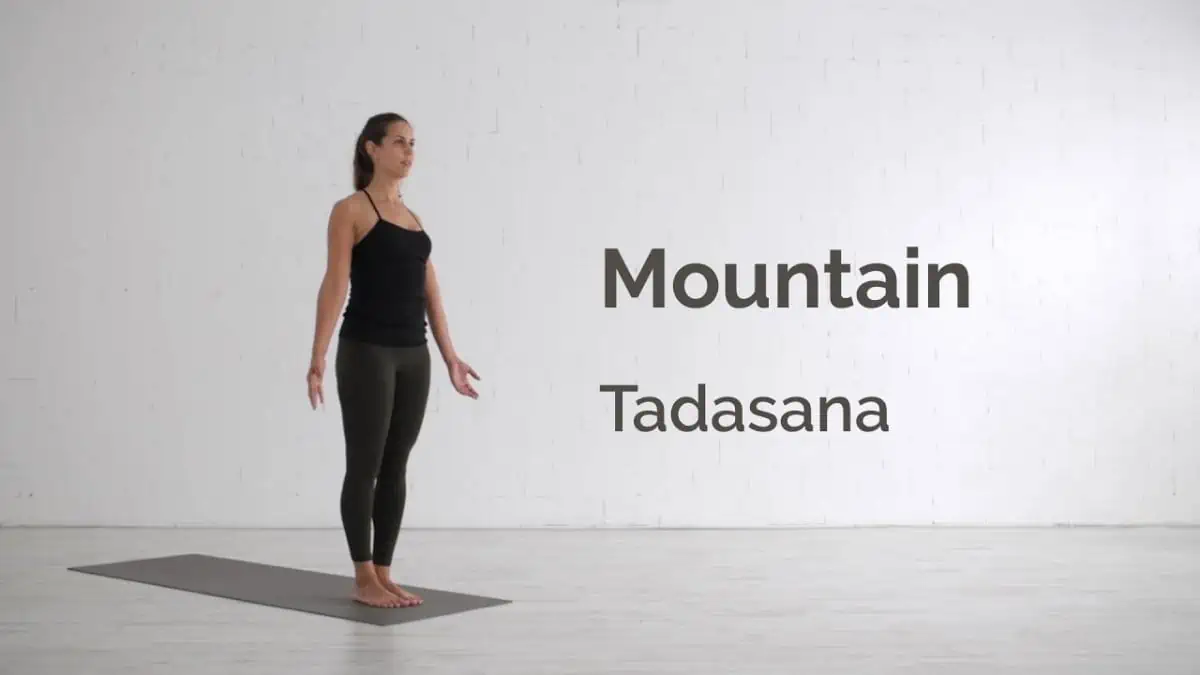Key Takeaway
Mountain Pose (Tadasana) is a foundational yoga posture that strengthens the body, improves posture and balance, and fosters mental clarity and focus, serving as the groundwork for all other standing yoga poses.
| MOUNTAIN POSE | |
|---|---|
| Alternate name: | Tadasana |
| Difficulty level: | Beginner |
| Pose category: | Standing Pose |
| Muscle groups: | Quadriceps (thighs) Hamstrings (thighs) Gluteal muscles (buttocks) Abdominals (torso) Erector spinae (back) Trapezius (upper back) Rhomboids (upper back) Deltoids (shoulders) Gastrocnemius and Soleus (calves) |
| Physical benefits: | Strengthens leg muscles, improves posture, lengthens spine, and improves balance. |
| Therapeutic applications: | Improves posture, strengthens back muscles and core. |
| Preparatory poses: | Savasana (Corpse Pose) Cat and Cow (Marjaryasana and Bitilasana) Downward Facing Dog (Adho Mukha Svanasana) |
| Counterposes that follow well: | Tree Pose (Vrksasana) Eagle Pose (Garudasana) |
| Chakras activated: | Muladhara Chakra (Root Chakra) |
| Most helpful prop: |  Yoga block between thighs - enhances inner thigh engagement. See latest price |
Picture a mountain, majestically rising out of the earth and reaching towards the sky. What sorts of words or qualities does that image evoke? You might say: strong, sturdy, grounded in its place with a solid foundation.
This is the intended effect of practicing Mountain Pose, or Tadasana. Don’t let the simplicity of the posture fool you: this beginner-level, basic standing pose (in fact, a foundational pose in most styles of yoga) carries more power than you may think at first glance!
The traditional name for Mountain Pose, Tadasana, comes from combining the Sanskrit words tada, or mountain and asana, meaning seat. In other styles of yoga such as Ashtanga, you may hear this pose called Samasthiti: sama, or equal and sthiti, which means “standing upright” or “standing position” — put these Sanskrit words together and you have “equal standing pose.”
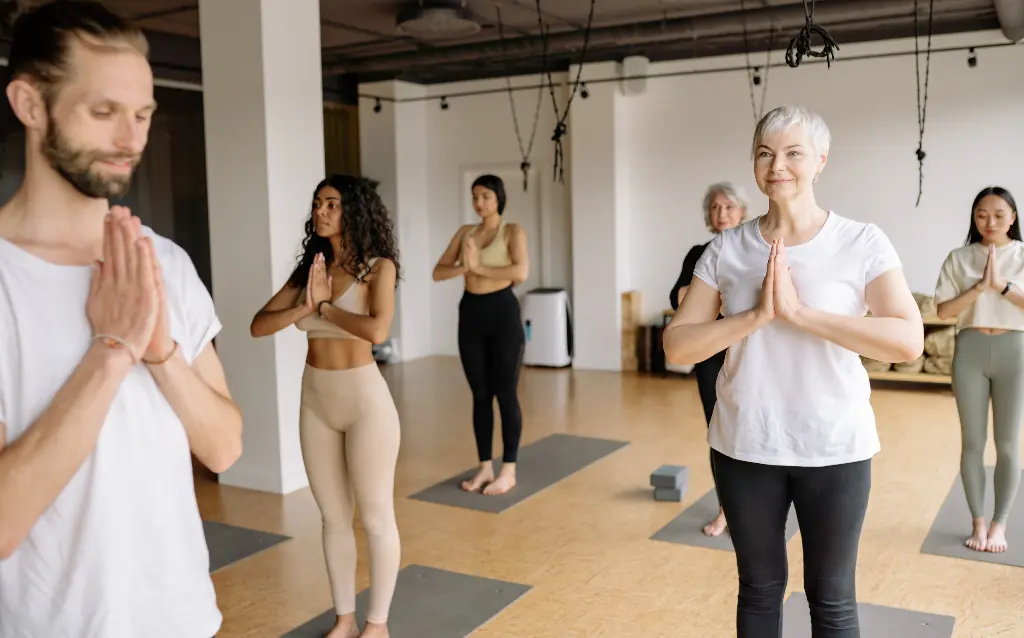
Typically, you’ll practice Mountain Pose in preparation for any other standing poses, balancing poses, and in yoga sequences like Sun Salutations. Throughout a yoga practice, you may return to Tadasana between different postures to re-ground, or to process the effects of the previous postures, and prepare for the next.
While it might seem like an incredibly simple yoga posture, the intention and effect of Mountain Pose is significant; furthermore, the name Tadasana is actually quite symbolic. When you stand tall with your feet grounded to the earth, top of your head reaching up to the sky, chest and shoulders open, it brings a sense of power.
You are connected to the space below you as well as above, just as a mountain rises from the earth towards the sky. So, while it might appear you are simply standing upright, there is much more happening on a mental and energetic level.
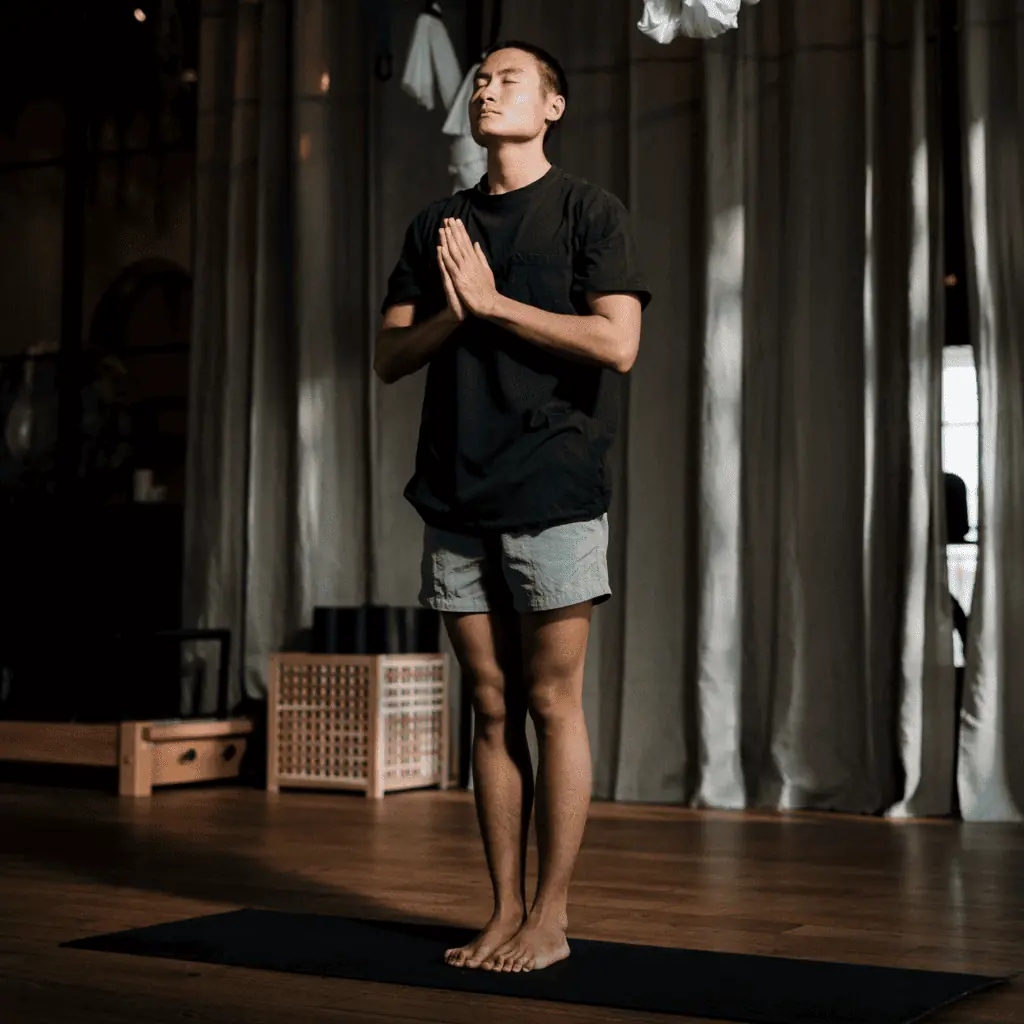
This foundational pose is one of the most important standing postures you can practice. It cultivates the feeling of stability, solid like a mountain, and provides a foundation for all other standing poses.
Watch our recommended steps for entering, holding, and exiting the pose.
Contents
Benefits Of Mountain Pose (Tadasana)
Building a solid foundation for the rest of your yoga practice is already a great reason to practice Tadasana. The many other physical and mental benefits of Mountain Pose prove that this is a worthwhile asana to spend some time in.
The specific physical benefits of practicing Tadasana are numerous and range from musculoskeletal improvements to deeper body awareness. Here are some of the most notable physical effects of practicing Mountain Pose:
- Strengthens the leg muscles to help stabilize joints
- Improves posture by arranging the body in optimal alignment
- Lengthens the spine and strengthens back muscles and core to support mobility and spinal flexibility
- Improves balance by strengthening the ankles, knees, and core
- Brings focus to body alignment, which translates to all other poses
- Opens the chest and torso, which promotes easier breathing
- Increases breath and body awareness
- Boosts energy to rejuvenate the body
Besides the wonderful physical impacts of this asana, Mountain Pose brings surprising mental benefits as well. Spending time in Tadasana can help:
- Bring stillness to the body and the mind, deepening mental clarity and inner peace, promoting a sense of calmness
- Build confidence
- Boost focus and concentration
- Cultivate present-moment awareness
It may be hard to believe the most basic of yoga postures can bring about such profound benefits. So, how about you try it for yourself? Keep reading to learn how to practice Mountain Pose with proper form.
How To Practice Mountain Pose (Tadasana)
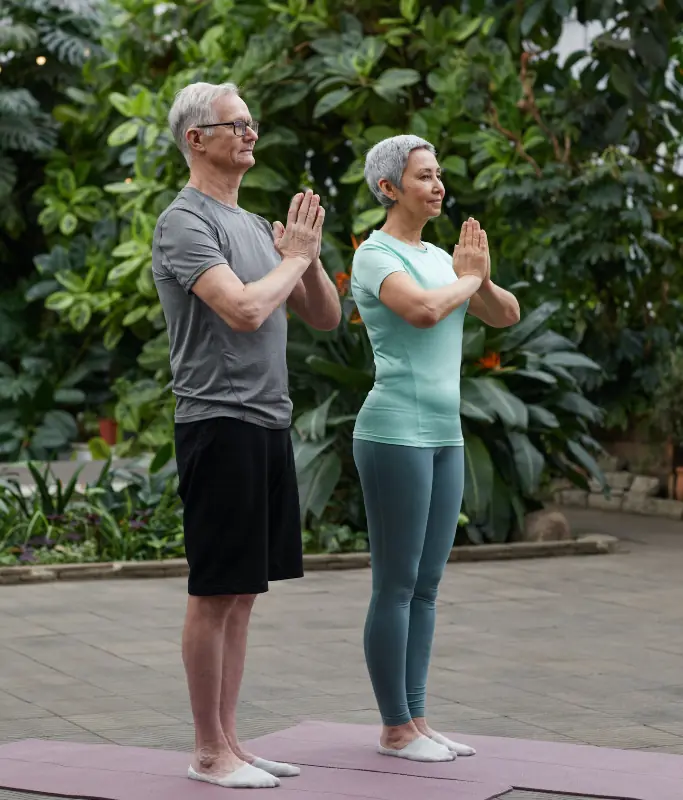
Tadasana (Mountain Pose) is considered to be one of the most important postures in yoga, as it creates a foundation for all other yoga poses. In this sense, the mental awareness required of this seemingly uncomplicated yoga pose are just as important as the physical alignment.
We’ve broken our instructions into step-by-step physical instructions, followed by some mental cues in order to achieve the maximum benefit of Mountain Pose.
Follow these step-by-step instructions to bring your body into Tadasana (Mountain Pose) from the ground up:
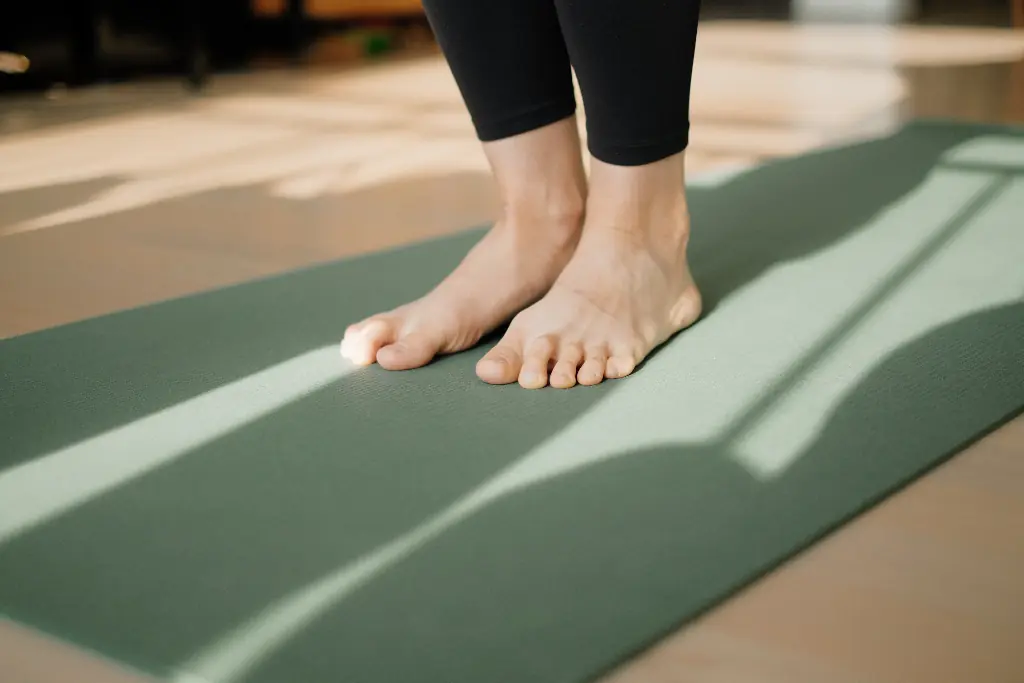
- Come to stand at the top of your yoga mat with your feet hip distance apart, toes pointing forward.
- Feel your feet grounded into the floor and lift through the inner arches of both feet. Keep your weight evenly distributed between both sides of your body.
- Pull up slightly on your knee caps to engage the thigh muscles. Keep your legs straight but avoid locking your knees.
- Spin your outer thighs slightly inwards to widen your sitting bones. Energetically squeeze your inner thighs toward your midline.
- Pull your navel in and up and draw your lower ribs together to engage your deep abdominal muscles.
- Bring your pelvis into a neutral position. To really feel this alignment, try tilting your tailbone up, slightly arching your lower back, then tucking your tailbone under; now, split the difference. Your sitting bones should be pointing toward the floor and you will feel a slight curve in your low back.
- Bring your arms to your sides with your palms facing forward. Feel your collarbones spread wide across your chest.
- Drop your shoulders down away from your ears and wide across your upper back, feeling your shoulder blades pulling down and apart.
- Elongate your neck and reach the crown of your head up towards the sky, your spine long. Feel yourself grow a couple centimeters taller.
- Stand tall in your Tadasana (Mountain Pose) for several breaths, as you bring deeper awareness to your alignment by following the mental prompts given below.
Mental Cues
Bringing your awareness to your alignment in Mountain Pose will help you practice proper alignment in all other asana.
- Feel your feet grounded into the floor.
- Notice how your joints are stacked.
- Feel the natural curves of your spine and the alignment of your pelvis.
- Feel your abdominal muscles activated to support your torso and keeping you upright.
- Be aware of what muscles are engaged in your legs and back.
- Every time you return to Tadasana during your yoga practice, take yourself through this mental checklist to develop your body awareness.
Contraindications
Since Mountain Pose is a basic, beginner-friendly posture, it is generally safe for nearly anyone to practice. However, there are certain cases where a supportive modification is required. If you experience vertigo, migraines, high or low blood pressure try practicing Mountain Pose in a Chair or with a wall support, as detailed in the next section.
Mountain Pose Modifications
When modifying yoga poses, it isn’t always about simplifying the asana. You might use modifications to make the pose more accessible, or to advance your experience in the posture.
Supportive Modifications
If you are recovering from an injury or working on building strength and balance, try practicing a supported version of Mountain Pose.
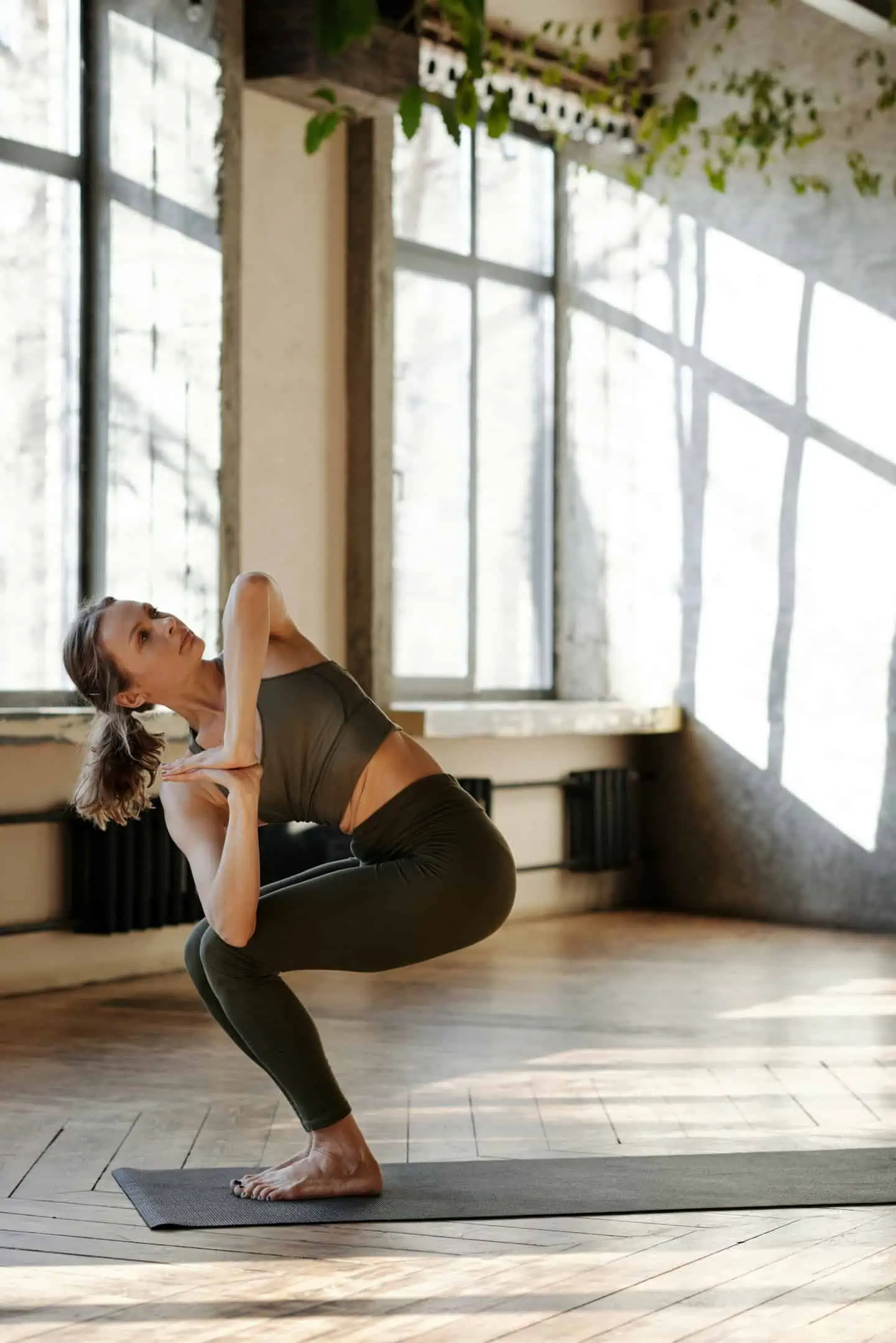
- Chair Yoga Mountain Pose: use a sturdy chair and sit a bit forward in the seat so your feet are firmly planted on the floor. Balance on your sitting bones by leaning forward slightly. Bring your arms straight at your sides and turn your palms forward. Follow the same cues as detailed above to engage your core, drop your shoulders, and open your chest and upper back. Lengthen through the crown of your head to keep your spine long.
- Wall Support: if you are working towards building a stronger core and back, or better balance, try practicing Mountain Pose against a wall. Stand with your buttocks against a wall. Depending on your body, your heels may be touching the wall, or slightly in front of it — just be sure your hips are aligned over your ankles. Point your sitting bones toward the floor so your pelvis is neutral. Roll your shoulders down and back so your chest and upper back are open. Your shoulder blades may or may not be touching the wall — the goal is to feel a straight line between your head, shoulders, hips, and ankles. Bring your arms to your sides with your palms forward and reach the crown of your head up toward the sky.
- Wider Stance: this incredibly simple modification is perfect for those who might feel a little wobbly in Mountain Pose (for example, if you are in your third trimester of pregnancy). To have an easier time finding your center of gravity, spread your feet a bit wider apart, hip width distance or little more. Keep your toes pointing forward and follow all other alignment cues detailed above.

Advanced Modifications
Once you feel stable in your Tadasana, give yourself a bit of challenge with these more advanced modifications.
- Close your eyes: to test your balance, try practicing Mountain Pose with closed eyes. Turn your awareness inwards and connect to your center of gravity to remain stable.
- Use a block: give your inner thigh muscles an extra workout by placing a block between your thighs and squeeze. This will also help you feel the slight internal rotation of your outer thighs.
Variations of Mountain Pose
Depending on the style of yoga, individual yoga teacher, or your own preference, there are numerous variations of Tadasana (Mountain Pose).
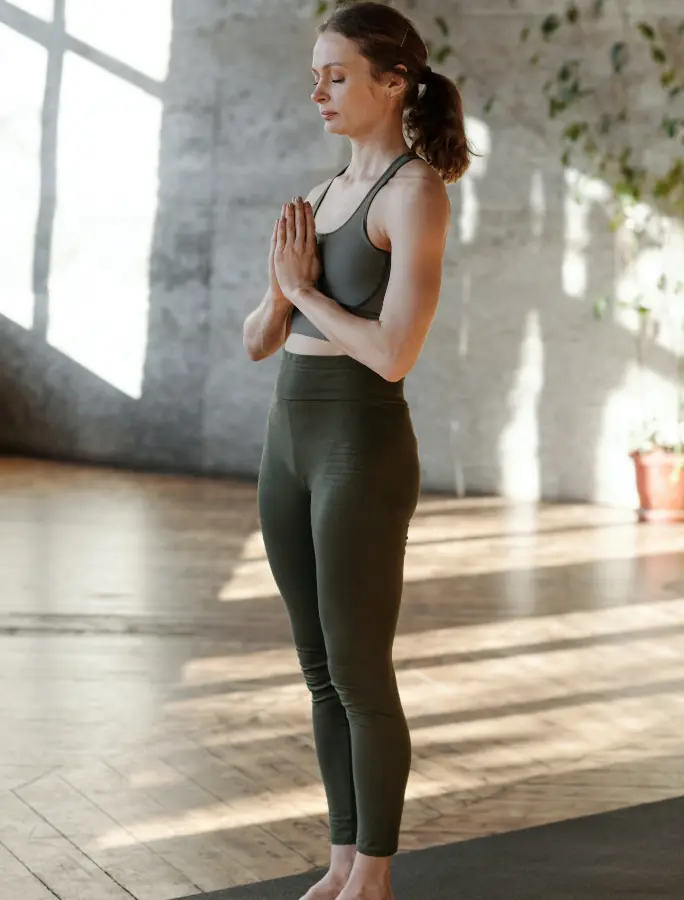
In Ashtanga Yoga, this posture is known as Samasthiti. It is traditionally practiced with the feet together, big toes touching and heels slightly apart. You may have your arms straight with your palms pressed against the sides of your legs, or with your hands pressed together in a prayer position.
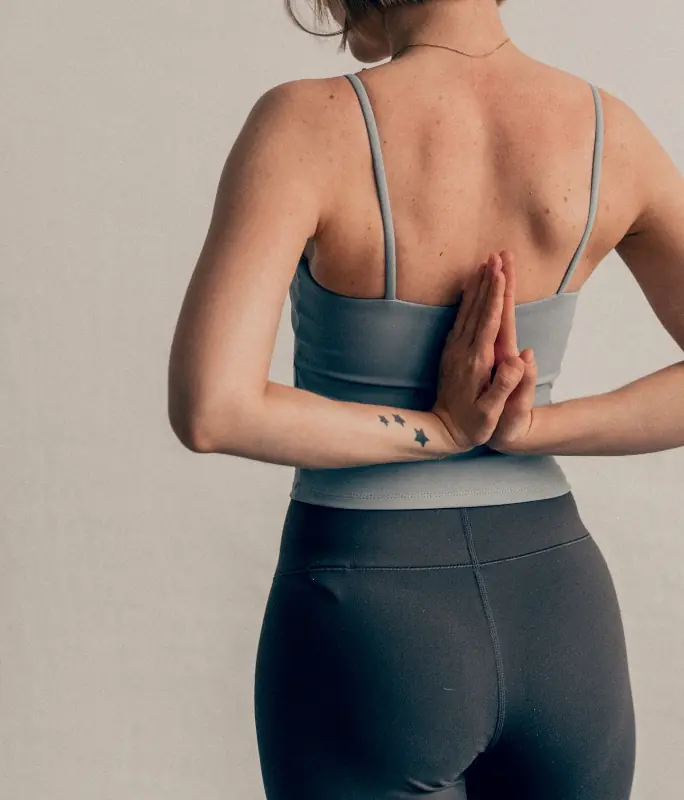
To that end, there are nearly endless variations for arm positions in Mountain Pose. Anjali Mudra (prayer position) is a classic and popular choice for many yoga teachers. Try keeping your lower body grounded and stable in Mountain Pose while you add different upper body variations like Reverse Prayer Pose, Eagle arms, Cow Face arms, or a spinal twist to make this basic pose a bit more interesting!

To lengthen your spine even more and stretch your entire body, try Extended Mountain Pose, which adds a little backbend to the posture. Reach your arms up over head with your palms facing each other (or try pressing your palms together). Lift up and out of your hips as you arch slightly backward, opening your heart to the sky.
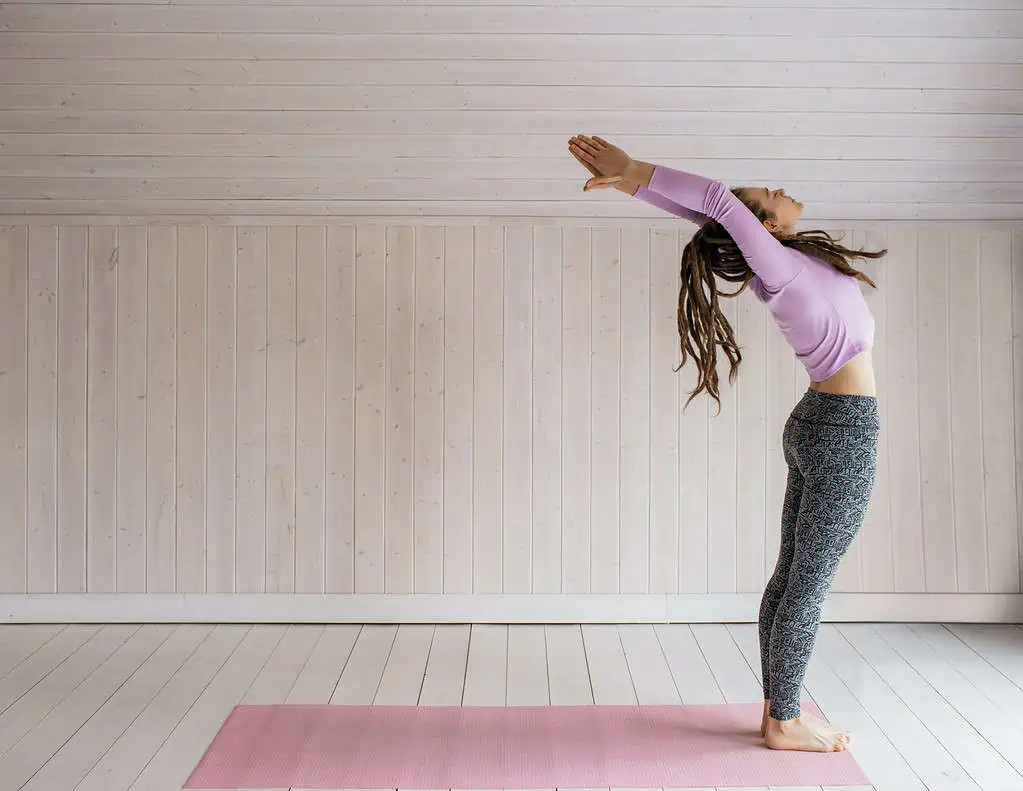
Preparatory Poses
Some yoga teachers may believe that as a foundational yoga pose, Tadasana requires no preparatory poses. However, most yoga classes will begin with a few stretches on the floor in order to focus the mind and warm up the body for a movement practice. Here are a few classic poses you can do before you get on your feet and into Tadasana.
Savasana
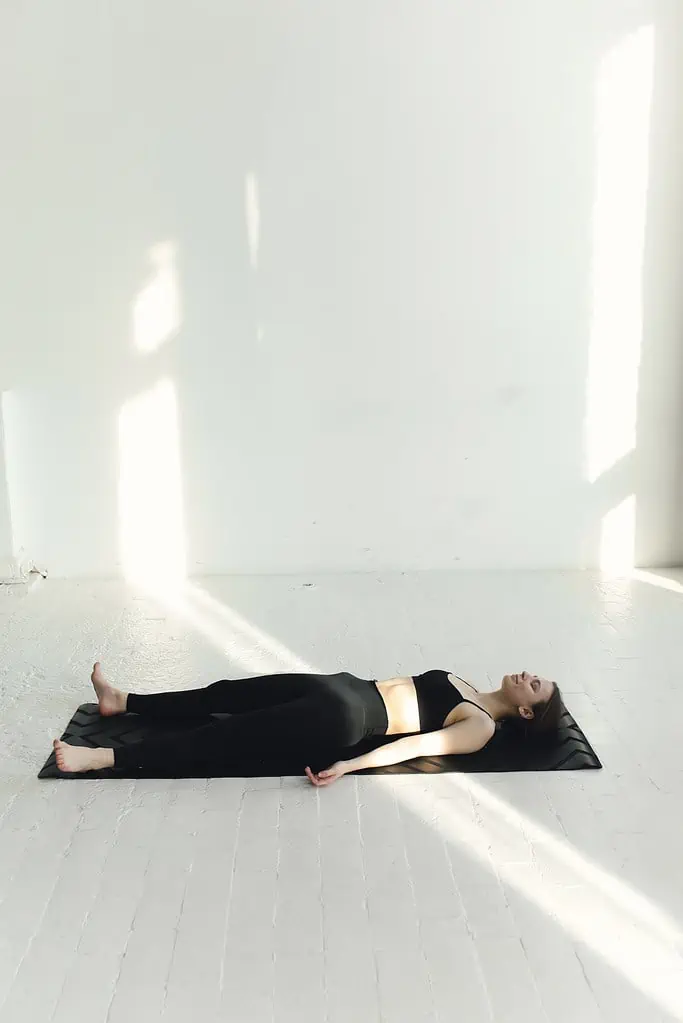
Beginning your yoga practice in Savasana will help you get grounded and connected to your body. Notice the alignment of your body while lying on the floor, and see how that translates when you bring yourself to your feet and into Tadasana.
Cat and Cow
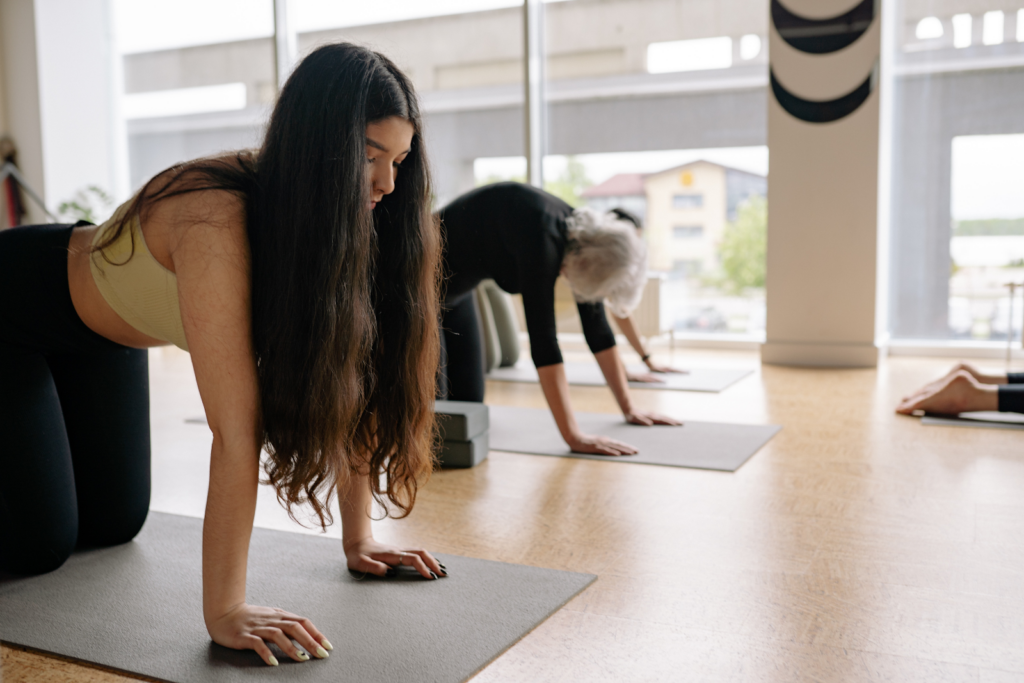
Cat and Cow stretch will help you release tension from your back muscles and start to warm up your back body. Take yourself through a few rounds of Cat and Cow to bring awareness especially to your pelvis and spine.
Downward Facing Dog
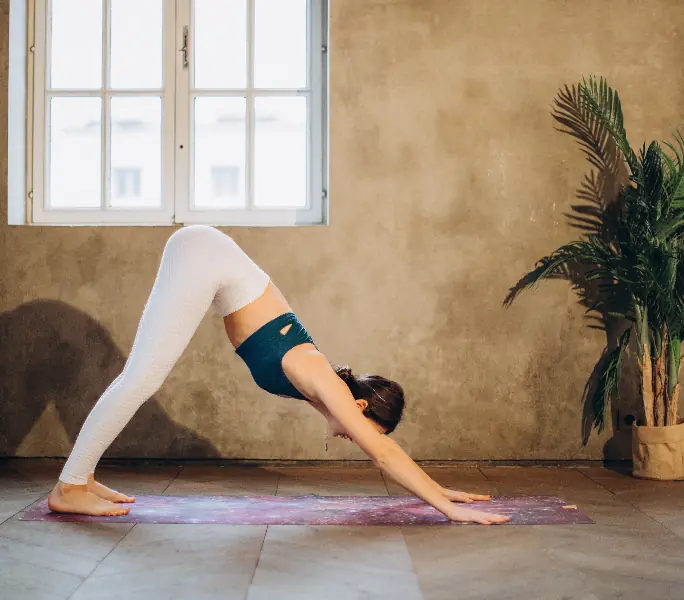
Before you come to an upright position, take a few breaths in Downward Dog to activate your legs and bring awareness to your lower body. Down Dog also helps you lengthen your spine, which will improve posture in Tadasana.
Yoga Poses to Practice After Tadasana
Since Mountain pose is all about finding your center, you will be ready to continue on with any number of standing yoga postures. Here are a couple standing asanas we think make a perfect progression from Tadasana.
Tree Pose
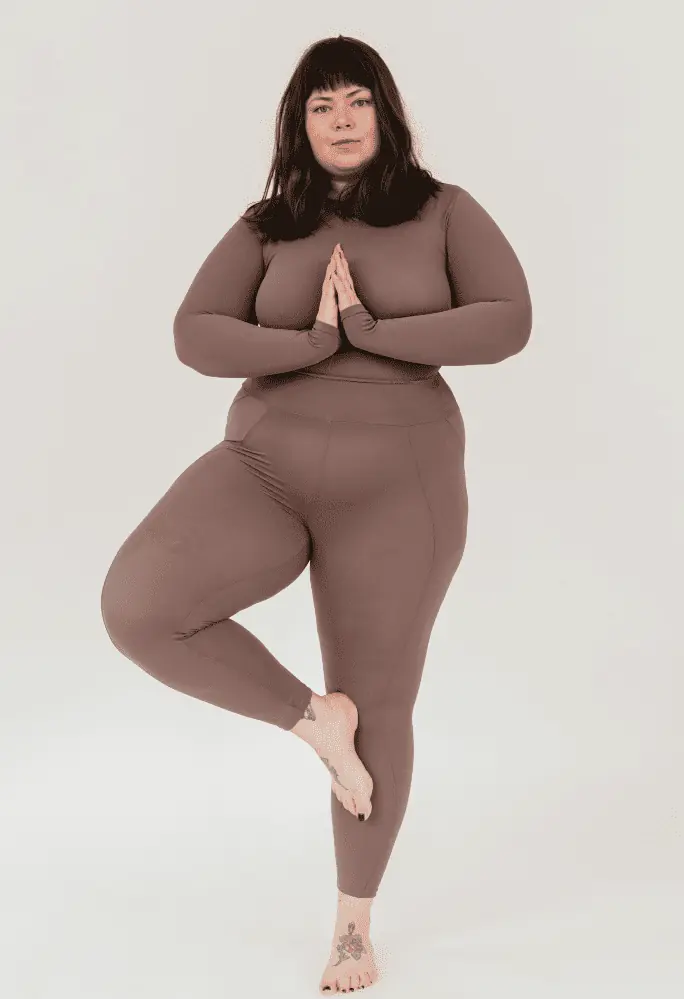
Follow up Mountain Pose with a classic balancing asana like Tree Pose. Check your balance and center of gravity as you stand on one leg. If you need a refresher on how to practice Tree Pose, check out our pose guide linked here!
Eagle Pose
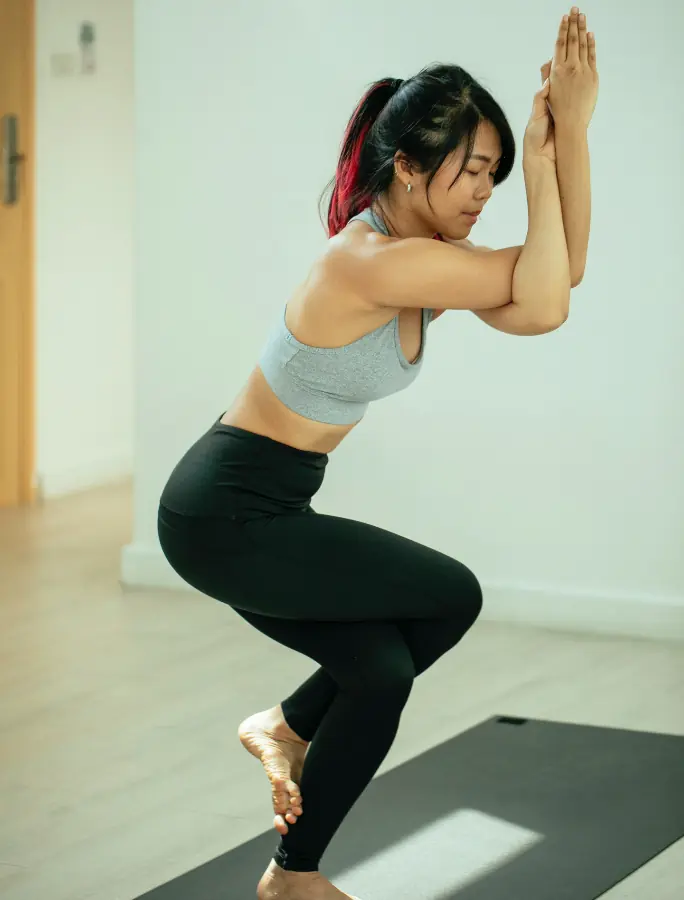
Feeling solid in both Mountain and Tree Pose? Level up your single-leg balance by moving onto Eagle pose. With both your legs and arms in a bound position, you’ll gain insight into just how grounded and strong you really are! Follow the instructions in our Eagle Pose guide here!
Sun Salutations
Rather than hold a balancing pose after Tadasana, you might feel ready to flow! You’ll be in the perfect position to start some Sun Salutations and get your blood circulating. For a review on practicing Sun Salutations, check out our Beginner’s Guide to Sun Salutations.
Common Questions About Mountain Pose
How long should I stay in Mountain Pose?
You may stay for just a few breaths when you come to Mountain Pose between other postures. When beginning your yoga session or before flowing through certain yoga sequences like a Sun Salutation, try to hold your Mountain Pose for one minute to focus your attention and bring awareness to your alignment.
Should I stand with my feet together or apart?
You can practice Mountain Pose either way, with your feet together or separated. The difference in body position largely comes down to personal preference and style of yoga. For example, in Ashtanga yoga, traditionally the feet are together. In other styles such as Iyengar yoga, the feet are placed at about a hip width distance.
Of course, depending on your individual body structure, you might find one stance more comfortable and stable than the other. Try experimenting by standing both ways to discover which stance feels best in your own body.
Should I tuck my tailbone in Mountain Pose?
You may have heard some yoga teachers give the cue to tuck the tailbone slightly in Mountain Pose. However, this can lead to a common misalignment where the lower back becomes flattened. Ideally, the pelvis should stay in a neutral position with the sitting bones pointing down toward the floor. This way, you will maintain the natural curves of the spine.


